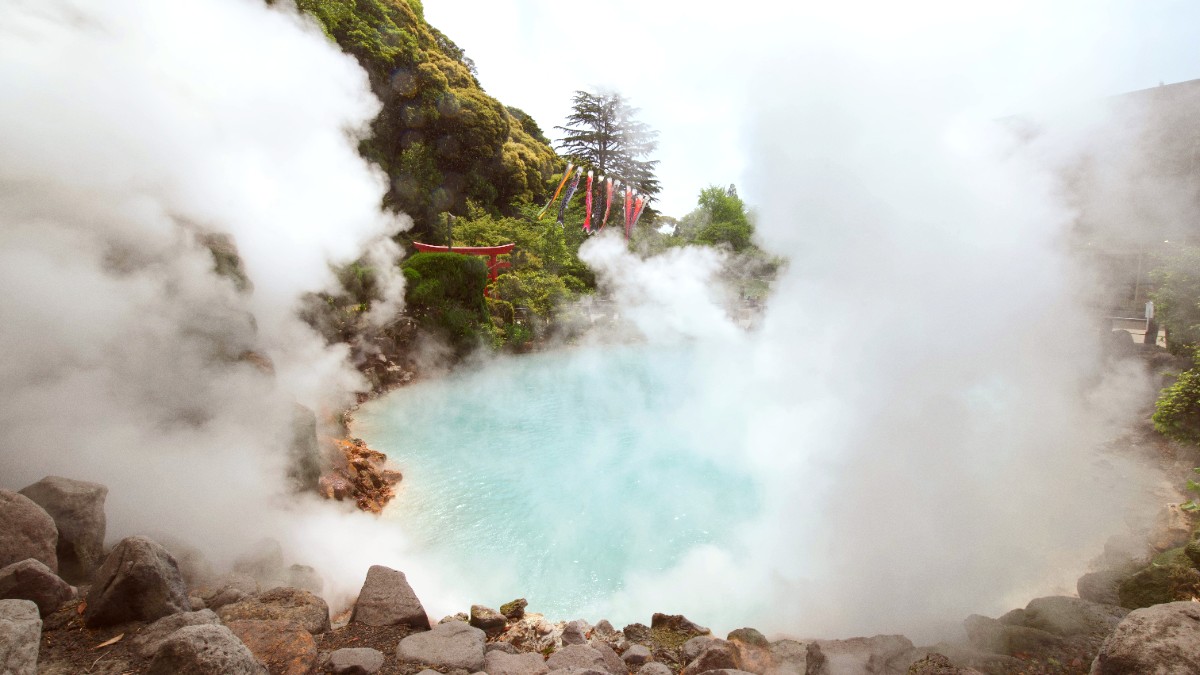
Kyushu, Japan
Beppu's cuisine ties heavily to its geothermal activity. This natural resource led to the development of Jigoku-mushi (hell-steamed) cooking, where food prepares using the natural steam from the hot springs. Fresh seafood from Beppu Bay and local agricultural produce from Oita Prefecture also form central components of the regional diet. Oita is known for its "Toyonokuni" brand, which signifies high-quality local ingredients. The history of utilizing the hot springs for everyday life, including cooking, shaped the local culinary traditions.
Ingredients include seafood (especially mackerel and horse mackerel from Beppu Bay), chicken, local vegetables (like shiitake mushrooms), and kabosu citrus. Geothermal steam is a cooking medium. Flavors are often subtle and fresh, emphasizing the natural taste of ingredients. Soy sauce, dashi (broth), miso, and local citrus (kabosu) are prominent seasonings. Kabosu adds a distinctive tangy aroma to many dishes.
Say "Itadakimasu" (I humbly receive) before a meal, and "Gochisousama" (Thank you for the meal) after.
Do not stick chopsticks vertically into rice bowls; this resembles funerary rites. Avoid passing food directly from chopstick to chopstick. Do not point with your chopsticks. When not using them, rest them on a chopstick rest.
Slurping noodles is acceptable. Tipping is not customary and can cause confusion. Sharing dishes is acceptable, especially at izakayas. When drinking, wait for everyone's drink to be served before saying "Kanpai!" (cheers). Pour drinks for others, and allow others to pour for you.
Food, including seafood, meat, vegetables, and eggs, cooked using the natural steam from the hot springs. This method is healthy and imparts an unique, subtle flavor.
Where to find: Jigoku Mushi Kobo Kannawa (a public steaming workshop where you cook your own food), and various ryokan and restaurants in the Kannawa area.
Fresh local fish, frequently horse mackerel or mackerel, marinated in a special sauce made with soy sauce, mirin, sake, and sesame.
Where to find: Seafood restaurants and izakayas.
Eggs slow-cooked in hot spring water, resulting in an unique soft-boiled texture with a creamy yolk and barely set white.
Where to find: Sold at many Beppu Hells sites and some onsen shops.
Pudding steamed using onsen steam, giving it a distinct flavor and texture.
A traditional Oita snack made from flat, udon-like noodles mixed with kinako (roasted soybean flour) and sugar.
Some high-end ryokan provide exquisite multi-course kaiseki meals. These elaborate dinners feature seasonal and local ingredients, often served in your room or a private dining area. Reservations are usually required for these experiences. Several restaurants specializing in Bungo Beef (Oita's renowned wagyu) offer premium dining experiences.
Numerous options exist for mid-range dining, including sushi restaurants, ramen shops, udon shops, and izakayas (Japanese pubs serving a variety of small dishes). You find these establishments throughout Beppu, notably around Beppu Station and in the Kannawa area. They offer a good balance of quality and price.
Shokudo (casual diners), ramen/udon shops, and convenience stores (7-Eleven, Lawson, FamilyMart) provide very affordable and convenient meal options. Look for bento boxes (pre-packed meals), onigiri (rice balls), sandwiches, and hot snacks at convenience stores. These offer quick and satisfying meals at a low cost.
Ramen is a popular Japanese noodle dish, consisting of Chinese-style wheat noodles served in a meat or (occasionally) fish-based broth, often flavored with soy sauce or miso, and with toppings like sliced pork (chāshū), nori (dried seaweed), menma (bamboo shoots), and scallions.
Widely available in Beppu's mid-range and budget eateries.
Ramen has evolved into a cultural icon, with numerous regional variations across Japan. It represents a quick, satisfying, and deeply flavorful meal. Slurping noodles loudly is considered a sign of enjoyment and appreciation in Japan.
A quintessential Japanese dining experience.
Public facility for onsen steam cooking.
You can bring or purchase ingredients.
Steamed pudding is a popular item.
A fun and interactive cooking experience.
Halal and Kosher availability remains extremely limited in Beppu.
Self-catering or relying on convenience stores for suitable packaged foods might be the best approach for these dietary needs.
Dining gluten-free in Japan is difficult, as soy sauce, which contains wheat, is pervasive in Japanese cuisine. Cross-contamination also poses a concern.
Carry an allergy card translated into Japanese clearly stating your dietary restrictions. Consider bringing some Gluten-free snacks from home.
The HappyCow app is an excellent resource for finding vegetarian and vegan restaurants worldwide, including in Beppu.
Seasonal fish and vegetables are always emphasized in Japanese cuisine. Look for special sweets or festive dishes that may appear during local festivals.
Some onsen facilities or local cooking schools might offer workshops on Jigoku-mushi or other local Oita dishes. Inquire at the Beppu Tourist Information Center for current offerings.
While not a major tourist activity directly within Beppu, you may find opportunities for farm visits or to meet food producers in rural parts of Oita Prefecture.
Local food markets and small festivals occasionally occur in Beppu. Check local tourism calendars or the Beppu Tourist Information Center for information on any food-related events happening during your visit.
This is a public facility where you rent a steaming pot and cook your own food using the onsen steam. You can bring your own ingredients or purchase them on-site.
This provides a fun, interactive, and healthy cooking experience unique to Beppu.
Staying at a ryokan often includes elaborate multi-course kaiseki dinners. These meals feature seasonal and local ingredients, often served in the privacy of your room or a dedicated private dining area.
This offers a deeply traditional and refined Japanese dining experience.
Depicts the unique method of cooking food using natural onsen steam at the facility.
Illustrates the hands-on aspect where visitors can prepare their own meals.
Shows the readiness of various ingredients for steaming, highlighting the freshness of the local produce.
While exploring Beppu's culinary delights, remember that reservations are advisable for fine dining, and most mid-range eateries are welcoming for walk-ins. Budget options like convenience stores are available 24/7 for snacks and quick meals.